- Author Jason Gerald [email protected].
- Public 2024-01-19 22:11.
- Last modified 2025-01-23 12:04.
Frosting is the best topping for cakes, cookies and cupcakes. However, you will be disappointed if the frosting is too runny and melts from the top of the baked goods. There are a variety of reasons why frosting needs to be thickened, and there are several methods you can try to make it solid. Choose the best method you can try to get the frosting back thick, fluffy, and soft.
Step
Method 1 of 5: Using Quick Solutions
Step 1. Find out if anything is wrong
This could be something that is beyond your control. If the frosting becomes too runny, it may be hot and humid and the ingredients are melting. Or, it's possible that you've added too much liquid by mistake. Whatever the case, you have nothing to worry about! The melted frosting can still be salvaged and turned into thick and creamy so it can still be used on baked goods.
Frosting also tends to crack when stored
Step 2. Stir in your frosting again
It's possible that the frosting didn't mix evenly, or it cracked during storage. Take a whisk or hand mixer and stir the frosting again for 3-4 minutes, and see if the frosting thickens.
This method is very easy to do so it's a good idea to try it first to see if it works
Step 3. Place the frosting in the refrigerator if the ingredients are too warm
Most frostings are made from oil or fat. So the frosting will melt when it gets too warm. If you left the frosting at room temperature or warmer, try placing it in the refrigerator for about 30 minutes, and see if the frosting thickens.
- Once removed from the refrigerator, beat the frosting again until smooth using a hand mixer.
- This method works best with butter or whipped cream-based frosting.
- Skip this method if you already know that your frosting isn't actually warm.
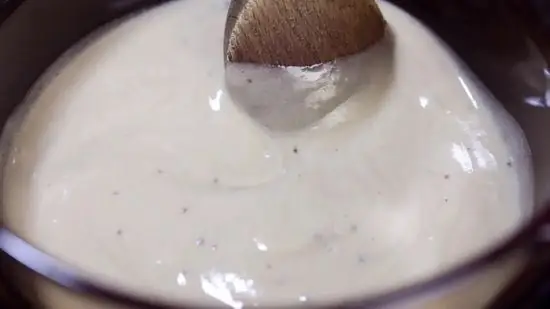
Step 4. Cook the hot frosting for a longer time
If the frosting on the stove still feels runny, reduce the liquid content in the frosting by prolonging the cooking time. Turn the stove over to medium heat and keep beating the frosting so it doesn't burn or brown.
- This method is very suitable for use on frosting that has been heated when cooked, such as boiled milk frosting.
- However, be careful when using this technique. If you cook it too long, the frosting may scorch or spoil. Keep stirring the frosting as it cooks, and if it doesn't thicken after you've cooked it for a few minutes, turn off the heat and try another method.
Method 2 of 5: Adding Dry Thickener

Step 1. Add powdered sugar
Most frostings contain powdered or icing sugar, and a common way people thicken light frosting is to add powdered sugar gradually to balance the liquid. Add 1-2 tbsp. (15-30 ml) powdered sugar at a time, then stir and check for consistency.
- If you add a large amount of sugar right away, the frosting can become too thick and too sweet. If this is the case, you'll need to balance it by adding liquid ingredients, and the frosting will continue.
- Powdered sugar contains cornstarch. The flour content will absorb the liquid and prevent the sugar from hardening.
- The use of powdered sugar is perfect for frosting from cream cheese.
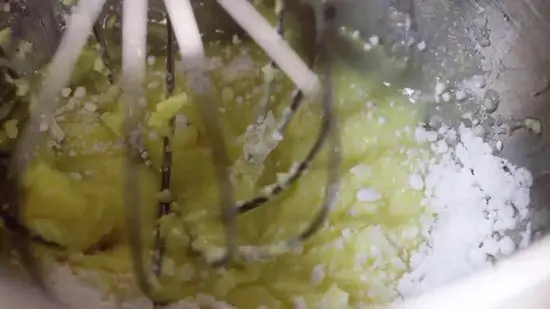
Step 2. Add a little meringue powder along with powdered sugar
Add meringue powder to reduce the sweetness of the powdered sugar. This can thicken the frosting, but does not add sweetness.
- In general, if you add more than 150 ml of powdered sugar to thicken a runny icing, also add 1-2 tsp. (5-10 ml) meringue powder. This is especially true of frostings that do contain meringue powder.
- Meringue powder is made from sugar, dried egg whites, and xanthan gum. Sugar can absorb liquids and xanthan gum is a natural thickening agent. However, don't overdo it, as this can make the frosting too thick and stringy.
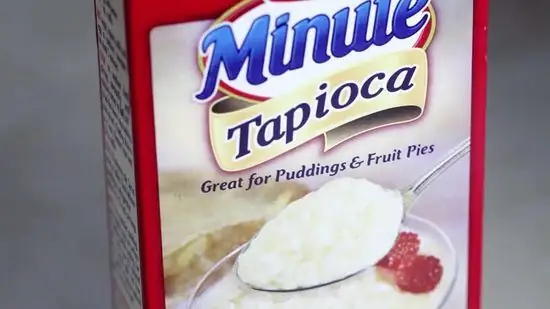
Step 3. Use starch, cornstarch, or arrowroot flour
This dry flour will absorb the liquid and can thicken the frosting without changing the taste. Add 1 tbsp. (15 ml) flour on frosting. Heat the frosting over low heat (if it can withstand high temperatures) while continuing to pour and stir in the flour. Turn off the stove immediately if the frosting starts to thicken.
- The most commonly used ingredient in frosting is cornstarch because it is not very shiny, almost tasteless, and is perfect for dairy products. However, cornstarch freezes at such a low temperature that it is not suitable for use in frosting that must always be stored in the refrigerator.
- Arrowroot flour is too shiny and is perfect for acidic liquids. This flour will usually turn into a slime when mixed with dairy products. However, if your frosting contains a highly acidic dairy product, such as buttermilk or sour cream, arrowroot flour is a good option. It will also thicken at low temperatures so it can be used in frosting that must be stored in the refrigerator.
- Starch also has a high gloss, but holds up well in cold temperatures and thickens at low temperatures. This makes it suitable for use in frosting that must be stored in the refrigerator.
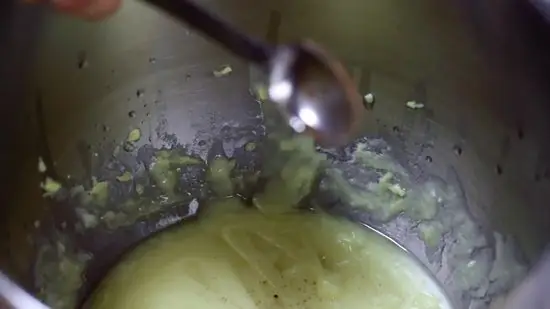
Step 4. Add cocoa powder if you have chocolate frosting
It's not really suitable for cream cheese, vanilla, and other non-chocolate frostings, but it's worth a try on chocolate frosting. Add 1-2 tsp of cocoa powder to the frosting. (5-10 ml) at a time. If you add too much cocoa powder, the frosting can become too dense and thick. Frosting can also turn bitter because cocoa powder has a fairly bitter taste.
- Cocoa powder can also work as a thickener, but you don't need to cook it if you want to thicken the liquid. For this reason, cocoa powder is a better ingredient than melted chocolate when you want to thicken your frosting.
- Unsweetened cocoa powder has a stronger thickening power than bittersweet chocolate. Cocoa powder contains more starch than bittersweet chocolate.
Step 5. Add gelatin so that the frosting doesn't change
To prevent the frosting from adding sweetness, pour the unflavored gelatin into cold or warm water. When the gelatin has dissolved, slowly pour the mixture into the frosting, stirring constantly, until the frosting thickens.
Try using cold water to dissolve the gelatin. This way, you don't have to wait for the mixture to cool before adding it to the frosting
Step 6. Add grated coconut for added flavour
If you already have coconut icing, you can add coconut to thicken the mixture. Add at least 5 grams of grated coconut to the frosting, then stir with a spatula.
Grated coconut can be purchased at the market, supermarket, or grocery store. You can also make your own using a cheese grater
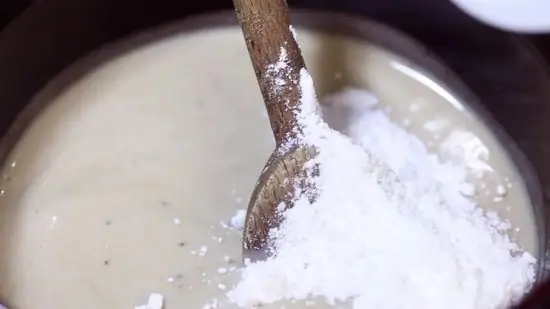
Step 7. Use wheat flour for the cooked frosting
If you're making warm, stove-top frosting, try thickening the light frosting with flour. Add about 1 tsp. up to 1 tbsp. (5-15 ml) of flour into the warmed frosting on the stove over low heat, then stir until it starts to thicken. Turn off the stove and continue to stir the frosting until it cools.
- However, don't use wheat flour in cold frosting. Wheat flour has a distinctive taste when eaten raw, and you'll need to cook it to get rid of that flavor.
- If not heated, the flour will not be able to thicken the frosting to its full potential.
- Immediately turn off the heat when the frosting begins to thicken. Overcooking the flour can make the frosting runny and runny again.
Method 3 of 5: Adding Wet Thickener
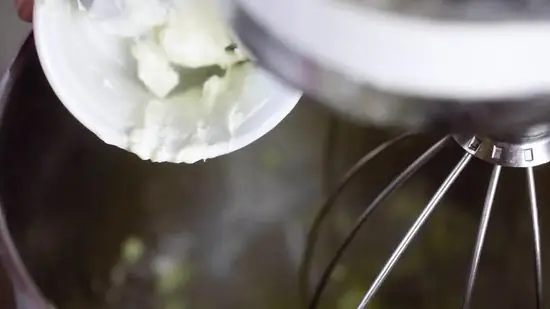
Step 1. Try using softened cream cheese
If the frosting is too sweet and runny, try adding cream cheese to thicken it and adding sourness to balance out the sweetness. Add about 30 ml of cream cheese and stir until well combined.
This is perfect for frosting that contains cream cheese or other ingredients that can be tastier if the sweetness is reduced
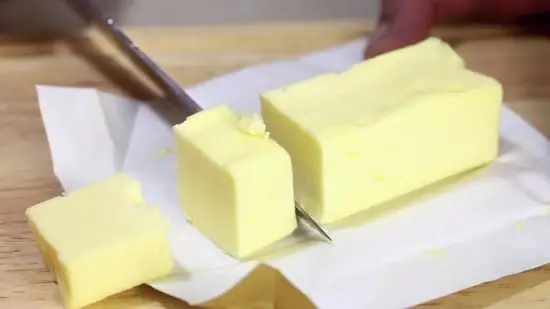
Step 2. Add butter or shortening (often called white butter)
If your frosting is butter or shortening, add more butter to thicken it. Add about 1 tbsp. (15 m) of butter or more at a time to avoid drastic changes in taste and consistency.
Remember, adding butter to the frosting may not have an immediate effect. When the frosting heats up while spinning with a mixer, the butter will melt and make the frosting runny. To accurately determine the thickness, place the frosting in the refrigerator
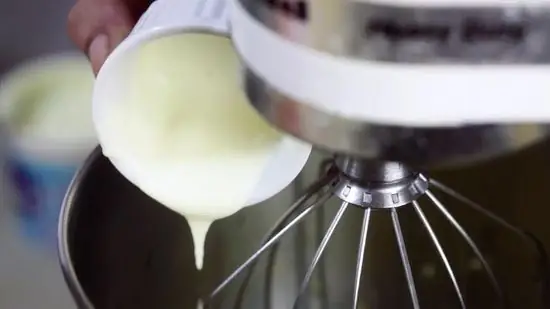
Step 3. Try adding heavy cream
In frosting that can be whipped and refrigerated, you can use heavy cream to thicken the frosting without making it too sweet. Add about 60 ml of heavy cream to the frosting, then beat until well blended.
- Cream makes the frosting thick and full.
- This is perfect if the frosting is going to be heated and whipped (after cream has been added). Heating the cream causes the frosting to shrink and become thicker. Beating the cream makes the frosting fluffy, which makes it a thicker, lighter texture.
Step 4. Use marshmallow fluff if you are making marshmallow butter cream
Marshmallow fluff has a combination of sticky and soft so it can be used to unite frosting ingredients. If you have used it in frosting, add 1-2 tbsp. (15-30 m) marshmallow fluff, then stir with a spatula.
Marshmallow fluff has a very sweet taste. Only use this ingredient if you really like a sweet taste
Method 4 of 5: Thicken Ganache
Step 1. Measure the wet ingredients thoroughly
Just one teaspoon of heavy cream can make the ganache runny and runny. When mixing frosting ingredients, use measuring cups carefully to avoid mistakes.
You will find it difficult to balance the ingredients if one ingredient is too much. Better to be safe than sorry later
Step 2. Use heavy cream or whipped cream
While most recipes call for this ingredient, you might consider replacing it with plain milk. However, the fat content in regular cow's milk is not enough for ganache, and you may end up with a runny frosting instead of a creamy, thick one.
Heavy cream and whipped cream can be found in grocery stores and supermarkets
Step 3. Find a recipe that matches the chocolate used
White chocolate is not the same as milk chocolate, and milk chocolate is not the same as dark chocolate. Be sure to pay attention to the type of chocolate you have to use so that it doesn't run out.
White chocolate generally produces a thinner ganache than dark chocolate
Step 4. Add a handful of chopped chocolate if the ganache is too runny
While the ganache is still warm, chop some chocolate (the same kind used in the recipe) and place in a bowl. Use a spatula to stir the chocolate until it melts and mix well until the mixture thickens.
- If the ganache has cooled while you're doing this, the chocolate won't mix and will cause the ganache to clump.
- If you want to reheat it, place the ganache in a double boiler and heat it carefully and slowly. If it is too hot, the oil in the mixture may split.
Method 5 of 5: Preventing Frosting From Too Watery

Step 1. Follow the recipe carefully
Making frosting may seem easy, but small changes to the ingredients can give it an unwanted thickness. Make sure to use the right ingredients and measurements for perfect results.
- Unsalted chocolate makes the frosting thicker than bittersweet or milk chocolate. Solid chocolate contains flour, and plain chocolate contains more solid chocolate, while sweet chocolate contains a lot of sugar and less flour. As a result, if the recipe calls for unsalted chocolate, but you use slightly sweeter chocolate, you'll end up with a runny frosting.
- Another example is milk and cream cheese. Usually, a frosting made from 2% milk with whole milk will give almost the same result. However, if the recipe calls for half and half cream (cream made from half whole milk and half heavy cream) or heavy cream, don't substitute all of it with milk. Likewise, low-fat cream cheese is known to produce a runny frosting if you use it in place of regular cream cheese.
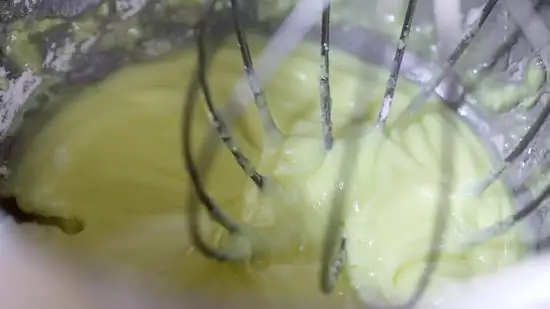
Step 2. Add the liquid ingredients at the last minute
Usually, the liquid ingredients for making the frosting are added at the last moment. Follow this procedure so that the frosting doesn't run out.
If you mixed the sugar and butter (or shortening) at the start, add the water and milk after that. In this example recipe, the ingredients are added to make the frosting easier to shake and spread. You have to add it carefully so that the frosting doesn't run out
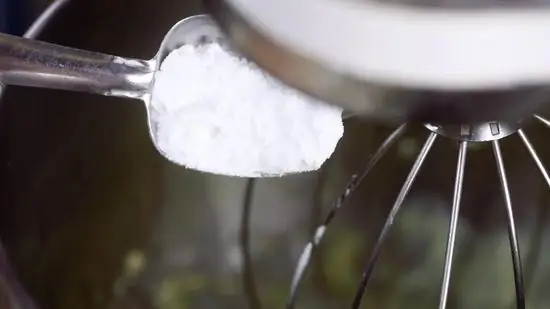
Step 3. Add ingredients slowly, and in small amounts
One of the main reasons why frosting isn't thick is adding too much ingredients, which can make the frosting messy. Both liquid ingredients and powdered sugar should be added slowly, in small amounts. If the frosting is too thick at first, you may end up adding too much liquid, which will make the frosting runny.
This is especially important when you are adding ingredients to thicken the frosting. A small amount is better than too much
Step 4. Be careful when using liquid flavorings, such as lemon juice
Some cream cheese frosting recipes call for a little lemon juice for added flavor. Apart from giving it a citrusy aroma, lemon juice also adds liquid ingredients to the mixture, which can make the frosting runny. If the recipe calls for lemon juice, you can replace it with grated lemon zest to avoid using too much liquid.






